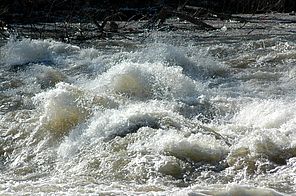January 2012
Dear Editors and Reporters,
Below is the January Lake Champlain Committee (LCC) Lake Look column "After the Floods – Did the Fish Survive?" which discusses fish survival following lake flooding and Irene.
LCC provides these columns to you on a monthly basis free of charge. The columns cover a wide range of Lake Champlain issues and natural history to help increase understanding of the lake and foster stewardship of this beautiful waterbody. If you print the column in a newspaper or magazine or use it in a blog, website or other electronic media, please be sure to reference the Lake Champlain Committee as the source and use our full name, logo (let us know if you need us to send you a jpeg) and the tagline that is included at the bottom of the column. Feel free to call us at 802 658-1414 for an interview about the current topic or other lake issues.
Thank you for helping to educate and engage residents and visitors about Lake Champlain. We welcome your questions, suggestions, and ideas for future columns.
Sincerely,
Lori Fisher, LCC Executive Director
Email: lorif@lakechamplaincommittee.org / Phone: 802-658-1414
After the Floods – Did the Fish Survive?

By Lake Champlain Committee Staff Scientist Mike Winslow
The past year will forever be remembered as the year of flooding. Record high lake levels in the spring were followed by Tropical Storm Irene in the late-summer. With such tremendous increases in the amount of water in the lake and in our rivers, how did aquatic organisms survive the disasters?
From the perspective of fish and other aquatic organisms the two events were quite different. In the case of lake flooding, water levels increased and stayed high for a period of weeks. Though substantial amounts of sediment entered the lake, most was dumped at the mouths of rivers, the typical area for deposition. Irene was a more dynamic event. Tremendous walls of water rushed through river valleys. Rivers cut new, sometimes temporary paths. Then, the water was gone in a matter of days.
Aquatic organisms are adapted to flooding. In the case of the lake, the increased amount of water as a result of spring flooding probably benefited them. Fish had access to more area including spawning and feeding sites. The lakeside forests and farm fields fish could swim through were likely filled with tasty insects, worms and snails to eat. Researchers have suggested that periodic flooding produces strong year classes for many fish species.
In the Amazon, a massive river system that floods annually, many fish species have evolved specifically to take advantage of flooding. For example, during floods the tambaqui feeds on fruit building up fat reserves that help them through drier seasons. The silver arawana or water monkey jumps from the water to feed on animals that have sought refuge from the flood on the lower branches of trees. The adaptations of our local fish are more general, but Northern pike use seasonally flooded wetlands to spawn.
The flooding associated with Tropical Storm Irene presented a different sort of challenge to fish, yet even here, the natural adaptations of fish species kept many individuals safe. Dave Mance, writing in Northern Woodlands magazine, identified three principle strategies brook trout use to survive river floods. The streamlined shape of the fish minimizes their resistance to water flow; their slimy skin reduces friction with the water; and the fish will change their behaviors to avoid the strongest currents. Behavior changes include sitting lower in the water column where currents are slower, hiding behind rocks and debris jams, and migrating to smaller side channels with less current.
Larger rivers allow fish a greater chance to escape the effects of floods. They have more complex structures offering more hiding places and they will overflow their banks offering fish access to slower side currents. However, in the smallest steepest streams, fish mortality can be significant.
One advantage fish had with regard to Irene is that the storm occurred in the late-summer. Individual fish are more vulnerable to flooding events when they are young. By late summer young of the year have grown enough to better withstand high flows.
Irene may even provide some benefits for fish. In the short term the storm washed insects and other land-based prey items into the water providing more food. In the long term the storm, carved deeper pools into the channel, increased hiding places by depositing woody debris and cleared out sediment thus improving spawning habitat.
Large invertebrates have a harder time coping with Irene-type floods. While many can use the same behavioral adaptations to avoid the worst of the flood waters, various studies have shown that populations decrease after floods, though they quickly rebound. On the other hand, mayfly and stonefly populations increase following floods as the flood scours sediment leaving the type of cobble habitats they prefer. Along the lake, floods probably just benefited aquatic invertebrates by giving them access to more surface area and food resources.
What will be more difficult for fish to adapt to is the dredging and straightening that accompanied our response to Irene. Dredging and straightening create uniform channel bottoms with limited cover. Both fish and their prey lack places to hide and the river reaches soon become biological wastelands.
Aquatic animals have survived floods for millennia; 2011 will be no different. As devastating as the floods were for people, flooding alone can actually improve conditions for many fish species. Excessive excavation of streams presents a more onerous challenge for them.
Lake Look is a monthly natural history column produced by the Lake Champlain Committee (LCC); it is free to LCC members via e-mail. LCC’s award-winning book Lake Champlain: A Natural History is available through the Lake Champlain Committee for $18.95 plus postage and handling. LCC is a citizens’ conservation organization that has been working in New York, Vermont and Quebec since 1963 to protect Lake Champlain’s environmental integrity and recreational resources. Get involved in lake protection by joining LCC using our website secure form (at www.lakechamplaincommittee.org), or mail your contribution (Lake Champlain Committee, 208 Flynn Avenue - BLDG 3 - STUDIO 3-F, Burlington, VT 05401), or contact us at (802) 658-1414, or lcc@lakechamplaincommittee.org for more information. |
